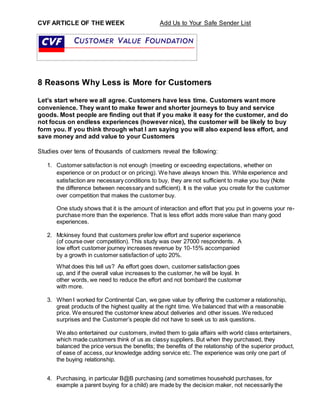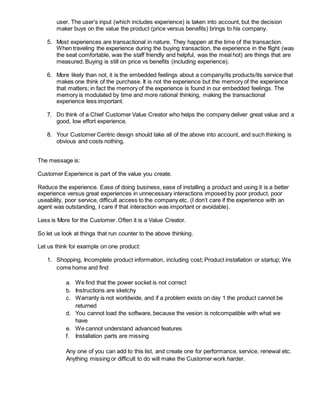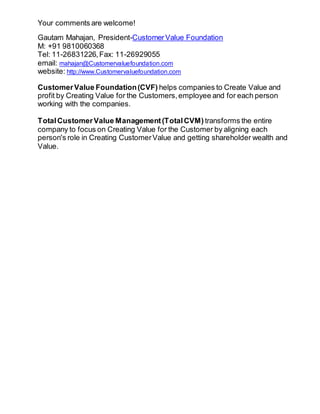When less is more for customers
- 1. CVF ARTICLE OF THE WEEK Add Us to Your Safe Sender List 8 Reasons Why Less is More for Customers Let’s start where we all agree. Customers have less time. Customers want more convenience. They want to make fewer and shorter journeys to buy and service goods. Most people are finding out that if you make it easy for the customer, and do not focus on endless experiences (however nice), the customer will be likely to buy form you. If you think through what I am saying you will also expend less effort, and save money and add value to your Customers Studies over tens of thousands of customers reveal the following: 1. Customer satisfaction is not enough (meeting or exceeding expectations, whether on experience or on product or on pricing). We have always known this. While experience and satisfaction are necessary conditions to buy, they are not sufficient to make you buy (Note the difference between necessary and sufficient). It is the value you create for the customer over competition that makes the customer buy. One study shows that it is the amount of interaction and effort that you put in governs your re- purchase more than the experience. That is less effort adds more value than many good experiences. 2. Mckinsey found that customers prefer low effort and superior experience (of course over competition). This study was over 27000 respondents. A low effort customer journey increases revenue by 10-15% accompanied by a growth in customer satisfaction of upto 20%. What does this tell us? As effort goes down, customer satisfaction goes up, and if the overall value increases to the customer, he will be loyal. In other words, we need to reduce the effort and not bombard the customer with more. 3. When I worked for Continental Can, we gave value by offering the customer a relationship, great products of the highest quality at the right time. We balanced that with a reasonable price. We ensured the customer knew about deliveries and other issues. We reduced surprises and the Customer’s people did not have to seek us to ask questions. We also entertained our customers, invited them to gala affairs with world class entertainers, which made customers think of us as classy suppliers. But when they purchased, they balanced the price versus the benefits; the benefits of the relationship of the superior product, of ease of access, our knowledge adding service etc. The experience was only one part of the buying relationship. 4. Purchasing, in particular B@B purchasing (and sometimes household purchases, for example a parent buying for a child) are made by the decision maker, not necessarily the
- 2. user. The user’s input (which includes experience) is taken into account, but the decision maker buys on the value the product (price versus benefits) brings to his company. 5. Most experiences are transactional in nature. They happen at the time of the transaction. When traveling the experience during the buying transaction, the experience in the flight (was the seat comfortable, was the staff friendly and helpful, was the meal hot) are things that are measured. Buying is still on price vs benefits (including experience). 6. More likely than not, it is the embedded feelings about a company/its products/its service that makes one think of the purchase. It is not the experience but the memory of the experience that matters; in fact the memory of the experience is found in our embedded feelings. The memory is modulated by time and more rational thinking, making the transactional experience less important. 7. Do think of a Chief Customer Value Creator who helps the company deliver great value and a good, low effort experience. 8. Your Customer Centric design should take all of the above into account, and such thinking is obvious and costs nothing. The message is: Customer Experience is part of the value you create. Reduce the experience. Ease of doing business, ease of installing a product and using it is a better experience versus great experiences in unnecessary interactions imposed by poor product, poor useability, poor service, difficult access to the company etc. (I don’t care if the experience with an agent was outstanding, I care if that interaction was important or avoidable). Less is More for the Customer. Often it is a Value Creator. So let us look at things that run counter to the above thinking. Let us think for example on one product: 1. Shopping, Incomplete product information, including cost; Product installation or startup; We come home and find a. We find that the power socket is not correct b. Instructions are sketchy c. Warranty is not worldwide, and if a problem exists on day 1 the product cannot be returned d. You cannot load the software, because the vesion is notcompatible with what we have e. We cannot understand advanced features f. Installation parts are missing Any one of you can add to this list, and create one for performance, service, renewal etc. Anything missing or difficult to do will make the Customer work harder.
- 3. Your comments are welcome! Gautam Mahajan, President-CustomerValue Foundation M: +91 9810060368 Tel: 11-26831226,Fax: 11-26929055 email: mahajan@Customervaluefoundation.com website: http://www.Customervaluefoundation.com CustomerValue Foundation(CVF) helps companies to Create Value and profit by Creating Value for the Customers,employee and for each person working with the companies. TotalCustomerValue Management(TotalCVM) transforms the entire company to focus on Creating Value for the Customer by aligning each person's role in Creating CustomerValue and getting shareholder wealth and Value.



